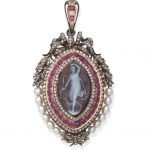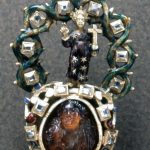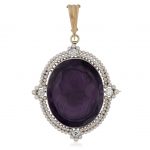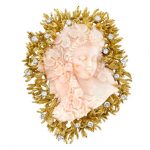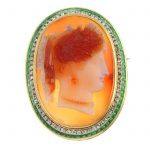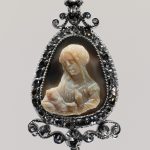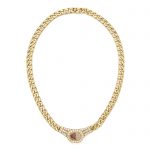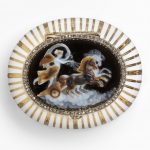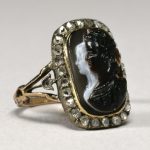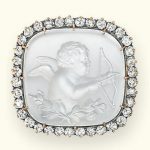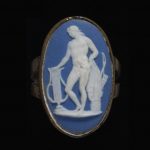Diamonds have often been used to set around the finest of cameos. The crystal clear stones enhance the look of the cameo. Many of these cameos would have been carved from other semi-precious gemstones such as amethyst, sardonyx and even emerald.
The cut of diamonds used in jewellery can help identify the age of the piece as many cuts are now no longer used although some cuts are making a comeback in fashion. The website Brilliant Earth has more information the different cuts.
An agate and gem-set cameo brooch/pendant, circa 1870 The navette-shaped banded agate cameo carved to depict Diana the Huntress, within tiered surrounds of rose-cut diamonds and cushion-shaped rubies, surmounted by a pierced ribbon cresting with a garland surround of rose-cut diamonds and 3.0mm-4.1mm pearls, the suspension loop similarly-set with cushion-shaped diamond accents, the reverse revealing a glazed oval compartment, mounted in silver and gold, pearls untested, length 6.5cm
Sold for £ 8,000 inc. premium at Bonhams in 2018
Spanish cameo; jacinth; bust of woman, facing, hair falling over shoulders; in gold pendant jewel containing enamelled figure of youthful Christ in attitude of benediction; settings with diamonds. Date 16thC
Reference: © The Trustees of the British Museum
ANTIQUE AMETHYST CAMEO SEED PEARL AND DIAMOND BROOCH PENDANT
PROPERTY FROM A PRIVATE MIDWEST COLLECTION Designed as an amethyst cameo within a seed pearl and diamond frame, mounted in platinum and gold Metal: 14k yellow gold and platinum Diamonds: 4 round diamonds with approximate total weight of 0.40 carats Stones: 1 oval carved amethyst cameo measuring 30 x 25 x 13.4 mm; approximately 120 seed pearls Size/Dimensions: 4.0 x 4.5 cm Marks: 14 Gross Weight: 22.1 grams Circa 1895
Sold for USD 2750.00 at Christies in 2018
Gold, Angel Skin Coral Cameo and Diamond Clip-Brooch Double coral cameo ap. 56.0 x 42.0 mm., 18 round diamonds ap. 3.15 cts., ap. 66.3 dwts. gross. 3 1/4 x 2 5/8 inches.
Tests as 18 kt. Coral: light whitish pink and light pink, nice carving, good luster. Diamonds: H-I-VS-SI. Good condition. Normal wear. 3 1/4 x 2 5/8 inches.
Sold for $1,250 (includes buyer’s premium) at Doyle New York in 2017
A late Victorian gold sardonyx cameo, diamond and enamel brooch. The oval sardonyx carved to depict Demeter, with rose-cut diamond and green enamel surrounds. Length 4.6cms. Weight 28.4gms. CONDITION Overall condition good to fair. Surface scratches in keeping with general age and wear. Diamonds well matched. Diamonds bright. Cut and setting of rose-cut diamonds prevents total carat weight estimation. Individual size and setting of diamonds prevents accurate colour and clarity assessment. Sardonyx is a banded orangish brown and creamy white hue, and is in good condition with minor chips to edge. Enamel is a vivid green hue. Small area of repair to enamel, some small surface chips.
Sold for £1,900 at Fellows in 2018
Sardonyx cameo of Mother and Child set in diamonds circa 1500, mount 19th century. The composition, with tenderly interacting figures, is arranged in the manner of early Netherlandish paintings of Madonnas. The Italian Renaissance brought with it a wholehearted embrace of classical antiquity throughout the fifteenth and sixteenth centuries. Emulation of ancient cameos played a large part. Carvers invested ancient myths with increasingly refined compositions and techniques, paying close attention to the latest archaeological discoveries. Demand for Italian carvers took them to all the courts of Europe. Milan in particular developed a taste for cameos with wondrous atmospheric effects.
Reference: The Metropolitan Museum of Art
Gold, Agate and Diamond Necklace, Bulgari The curb link chain centering an antique agate gryllos cameo, accented by round diamonds, gross weight approximately 45 dwts, length 15½ inches, signed Bulgari, numbered BU984.
Sold for 7,500 USD at Sotheby’s in 2018
Oval gold bonbonnière, with bands of white enamel and gold, the hinged lid with a layered agate cameo carved with Aurora in her chariot within rose-cut diamond border. The cameo is 19th century in date.
The strong design of this bonbonnière is original. Some of Fabergé’s boxes are clearly indebted to eighteenth-century century prototypes, such as the Rococo or Neo-classicism. The cameo shows Neo-classical influence, as does the oval shape, but the rounded sides and rayed decoration in enamel are a late nineteenth-century development. Mikhail Perkhin, whose mark is struck on the inside of the box, was Fabergé’s head workmaster from 1886 until his death in 1903.
Reference: © Victoria and Albert Museum
Cameo Ring with Marie Antoinette and her Son, the Dauphin
Jacques Guay carved cameo portraits of Queen Marie Antoinette, though it is not known whether he is the author of this one. The carver took advantage of the natural striations of color in the stone to differentiate between the two figures: the queen and her son, the dauphin (1785–95), who would have become Louis XVII, but for the French Revolution. Such a ring might have been worn by a courtier or, after the Revolution, by a royalist sympathizer. The cameo is surrounded by a border of diamond sparks in silver mounts. The forked shoulders each enclose a tulip originally set with a crystal.
Reference: The Walter Art Museum
